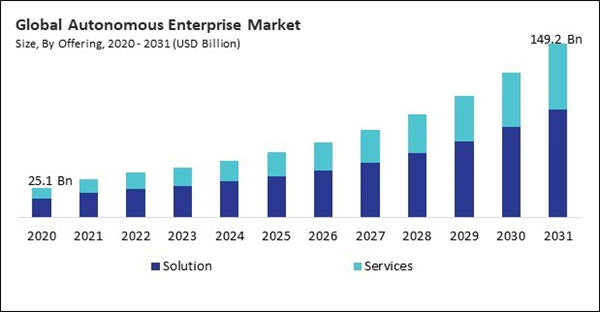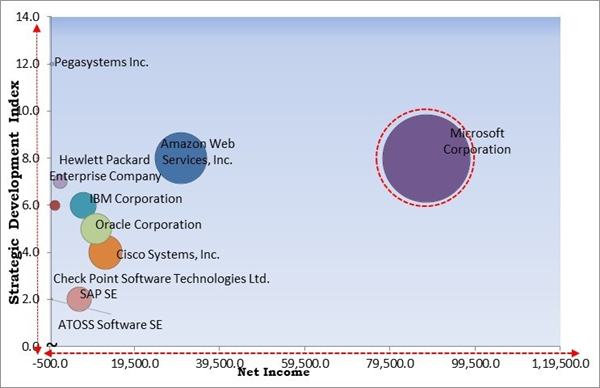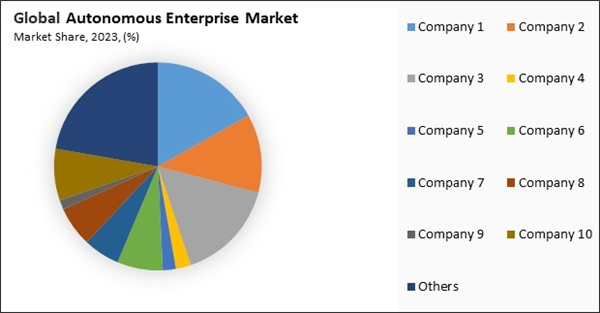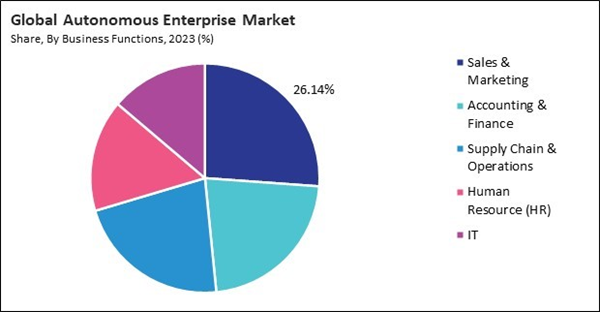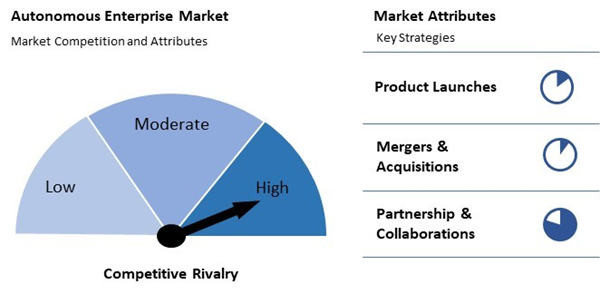The Global Autonomous Enterprise Market size is expected to reach USD149.2 billion by 2031, rising at a market growth of 17.2% CAGR during the forecast period.
The North America segment procured 39% revenue share in the autonomous enterprise market in 2023. This dominance is driven by the region’s strong technological infrastructure, high investment in AI and automation technologies, and widespread adoption of advanced enterprise solutions across manufacturing, healthcare, and financial services. The market growth in this region is further accelerated by the significant investments in autonomous systems by key participants such as IBM, Microsoft, and Amazon.
The major strategies followed by the market participants are Partnerships as the key developmental strategy to keep pace with the changing demands of end users. For instance, In January, 2024, Pegasystems partnered with Blackbuck Education to launch a post-graduate Digital Process Automation program. Hosted at JNTUH and IIDT, the program offers hands-on training, certifications, and career support, preparing graduates for roles in digital process automation and bridging industry skills gaps. Moreover, In September, 2024, Amazon Web Services and Oracle have announced a strategic partnership, integrating Oracle Autonomous Database and Exadata services into AWS. This collaboration simplifies cloud migration, enhances flexibility and security, and supports enterprise modernization through automated and optimized cloud solutions.
Based on the Analysis presented in the KBV Cardinal matrix; Microsoft Corporation is the forerunner in the Autonomous Enterprise Market. In October, 2023, Microsoft Corporation came into partnership with Siemens to drive cross-industry AI adoption. They introduced Siemens Industrial Copilot, an AI-powered assistant for enhanced human-machine collaboration, and integrated Siemens Teamcenter with Microsoft Teams to boost productivity across various industries. Companies such as Pegasystems Inc. and Amazon Web Services, Inc. are some of the key innovators in Autonomous Enterprise Market.
Additionally, the widespread adoption of cloud computing is revolutionizing the development of these enterprises by providing scalable and flexible infrastructure. Instead of relying on traditional hardware, businesses now have access to on-demand cloud resources, enabling them to deploy AI-driven automation with reduced costs. This shift is particularly evident in healthcare, retail, and financial services industries, where cloud platforms like Microsoft Azure, Google Cloud, and Amazon Web Services (AWS) support essential operations. Thus, businesses across industries increasingly turn to cloud computing to support their move toward automation and more efficient operations.
The leading players in the market are competing with diverse innovative offerings to remain competitive in the market. The above illustration shows the percentage of revenue shared by some of the leading companies in the market. The leading players of the market are adopting various strategies in order to cater demand coming from the different industries. The key developmental strategies in the market are Partnerships & Collaborations.
The autonomous enterprise market is driven by increasing demand for AI-driven solutions that enhance operational efficiency and decision-making. Competition centers around providing seamless automation, advanced analytics, and integration across industries like finance, manufacturing, and logistics. Key differentiators include technological innovation, scalability, and customization to address diverse business needs and challenges.
The North America segment procured 39% revenue share in the autonomous enterprise market in 2023. This dominance is driven by the region’s strong technological infrastructure, high investment in AI and automation technologies, and widespread adoption of advanced enterprise solutions across manufacturing, healthcare, and financial services. The market growth in this region is further accelerated by the significant investments in autonomous systems by key participants such as IBM, Microsoft, and Amazon.
The major strategies followed by the market participants are Partnerships as the key developmental strategy to keep pace with the changing demands of end users. For instance, In January, 2024, Pegasystems partnered with Blackbuck Education to launch a post-graduate Digital Process Automation program. Hosted at JNTUH and IIDT, the program offers hands-on training, certifications, and career support, preparing graduates for roles in digital process automation and bridging industry skills gaps. Moreover, In September, 2024, Amazon Web Services and Oracle have announced a strategic partnership, integrating Oracle Autonomous Database and Exadata services into AWS. This collaboration simplifies cloud migration, enhances flexibility and security, and supports enterprise modernization through automated and optimized cloud solutions.
KBV Cardinal Matrix - Market Competition Analysis
Based on the Analysis presented in the KBV Cardinal matrix; Microsoft Corporation is the forerunner in the Autonomous Enterprise Market. In October, 2023, Microsoft Corporation came into partnership with Siemens to drive cross-industry AI adoption. They introduced Siemens Industrial Copilot, an AI-powered assistant for enhanced human-machine collaboration, and integrated Siemens Teamcenter with Microsoft Teams to boost productivity across various industries. Companies such as Pegasystems Inc. and Amazon Web Services, Inc. are some of the key innovators in Autonomous Enterprise Market.
Market Growth Factors
AI and ML technologies are no longer limited to basic automation; they enable organizations to tackle complex decision-making processes, predict outcomes, and optimize operations with minimal human intervention. Robotic process automation (RPA) is one of the most frequently implemented AI technologies in the business sector. RPA uses AI and ML algorithms to perform repetitive and rules-based tasks traditionally handled by humans, such as data entry, invoice processing, and order management. Hence, advancements in AI and ML have allowed businesses to automate a wide range of operations.Additionally, the widespread adoption of cloud computing is revolutionizing the development of these enterprises by providing scalable and flexible infrastructure. Instead of relying on traditional hardware, businesses now have access to on-demand cloud resources, enabling them to deploy AI-driven automation with reduced costs. This shift is particularly evident in healthcare, retail, and financial services industries, where cloud platforms like Microsoft Azure, Google Cloud, and Amazon Web Services (AWS) support essential operations. Thus, businesses across industries increasingly turn to cloud computing to support their move toward automation and more efficient operations.
Market Restraining Factors
Autonomous enterprises rely on a foundation of cutting-edge technologies such as artificial intelligence (AI), machine learning (ML), and the Internet of Things (IoT). To create an ecosystem where these technologies can operate effectively, businesses must make substantial investments in purchasing infrastructure, which includes AI platforms, IoT devices, and cloud services. These components are expensive and require frequent updates to stay current with evolving technological standards. Hence, such cost disparities create significant bottlenecks in market growth.The leading players in the market are competing with diverse innovative offerings to remain competitive in the market. The above illustration shows the percentage of revenue shared by some of the leading companies in the market. The leading players of the market are adopting various strategies in order to cater demand coming from the different industries. The key developmental strategies in the market are Partnerships & Collaborations.
Driving and Restraining Factors
Drivers
- Advancements In Artificial Intelligence (Ai) And Machine Learning (Ml)
- Increased Adoption Of Cloud Computing
- Supportive Government Initiatives And Regulations
Restraints
- Substantially High Initial Investment Costs
- Data Privacy And Security Concerns
Opportunities
- Increased Cybersecurity Threats And Autonomous Defense
- Rising Demand For Personalized And Automated Marketing
Challenges
- Issues About Integration With Legacy Systems
- Lack Of Skilled Workforce
Offering Outlook
Based on offering, this market is bifurcated into solution and services. The services segment procured 37% revenue share in this market in 2023. Many organizations require expert assistance to integrate autonomous solutions with existing legacy systems, ensure compliance with regulations, and train personnel on new technologies. Moreover, the complexity of autonomous technologies often necessitates ongoing support and customization, further driving demand for services.Business Functions Outlook
On the basis of business functions, this market is classified into accounting & finance, IT, human resources (HR), sales & marketing, and supply chain & operations. The supply chain & operations segment acquired 22% revenue share in this market in 2023. Businesses are progressively utilizing autonomous solutions to oversee logistics, inventory, and production processes as supply chains become more intricate and global. Autonomous technologies, such as AI-powered demand forecasting, autonomous warehousing, and robotic process automation, are helping businesses optimize their operations by reducing human error, improving inventory accuracy, and enhancing the efficiency of logistics management.Application Outlook
By application, this market is divided into process automation, customer & employee engagement, order management, credit evaluation & management, predictive maintenance, and others. The order management segment garnered 17% revenue share in this market in 2023. As e-commerce and digital transactions continue to rise, businesses are adopting autonomous systems to manage orders more efficiently, ensuring timely fulfillment, reducing errors, and improving customer satisfaction.Vertical Outlook
Based on vertical, this market is segmented into BFSI, IT & ITeS, telecom, retail & eCommerce, healthcare, transportation & logistics, manufacturing, government & defense, and others. The IT & ITeS segment acquired 16% revenue share in this market in 2023. The IT and ITeS industry is at the forefront of digital transformation, leveraging advanced technologies such as AI, machine learning, robotic process automation (RPA), and autonomous networks to optimize operations. Automating IT operations, enhancing system reliability, and improving cybersecurity have become a crucial competitive advantage for companies in this sector.By Regional Analysis
Region-wise, this market is analyzed across North America, Europe, Asia Pacific, and LAMEA. The Asia Pacific segment acquired 26% revenue share in this market in 2023. The automation of manufacturing, logistics, and retail has been rapidly implemented by countries such as China, Japan, and South Korea. Government initiatives that encourage the adoption of artificial intelligence (AI) and the region's strong emphasis on digital transformation have contributed to the market's growth.Market Competition and Attributes
The autonomous enterprise market is driven by increasing demand for AI-driven solutions that enhance operational efficiency and decision-making. Competition centers around providing seamless automation, advanced analytics, and integration across industries like finance, manufacturing, and logistics. Key differentiators include technological innovation, scalability, and customization to address diverse business needs and challenges.
Recent Strategies Deployed in the Market
- Sep-2024: IBM Corporation came into partnership with Salesforce to deliver AI-driven agents through IBM's watsonx and Salesforce's Agentforce. This collaboration aims to enhance automation, productivity, and data integration, particularly for regulated industries, by integrating advanced AI tools within enterprise systems.
- Jun-2024: Hewlett Packard Enterprise (HPE) partnered with Sensei, a leader in autonomous stores, to enhance retail operations with advanced servers. This collaboration aims to improve real-time consumer insights and streamline checkout-free shopping, addressing modern consumer demands for convenience and efficiency.
- Jun-2024: Hewlett Packard Enterprise has launched new AI and hybrid cloud programs in collaboration with NVIDIA, aimed at boosting partner profitability. The initiative includes AI workshops, certifications, and enhanced HPE GreenLake offerings, designed to expand partner expertise and revenue opportunities.
- Jun-2024: Pegasystems Inc. announced the expansion of its product lineup with the introduction of its center-out approach and AI-driven tools such as GenAI Blueprint. This expansion focuses on centralizing business processes and data to boost efficiency and drive innovation, reinforcing Pega’s leadership in autonomous enterprise solutions.
- May-2024: IBM Corporation came into partnership with Palo Alto Networks to integrate AI-driven security solutions. IBM will provide consulting services and support, while Palo Alto Networks will incorporate IBM’s watsonx LLMs into its Cortex XSIAM platform.
List of Key Companies Profiled
- Microsoft Corporation
- IBM Corporation
- Amazon Web Services, Inc. (Amazon.com, Inc.)
- Check Point Software Technologies Ltd.
- Pegasystems Inc.
- Cisco Systems, Inc.
- Hewlett Packard Enterprise Company
- SAP SE
- ATOSS Software SE
- Oracle Corporation
Market Report Segmentation
By Offering
- Solution
- Robotic Process Automation
- Autonomous Networks
- Accounts Automation & Security Automation
- Autonomous Agents & Others
- Services
- Professional Services
- Managed Services
By Business Functions
- Sales & Marketing
- Accounting & Finance
- Supply Chain & Operations
- Human Resource (HR)
- IT
By Application
- Process Automation
- Customer & Employee Engagement
- Order Management
- Credit Evaluation & Management
- Predictive Maintenance
- Other Application
By Vertical
- BFSI
- IT & ITes
- Manufacturing
- Healthcare
- Transportation & Logistics
- Telecom
- Retail & eCommerce
- Government & Defence
- Other Vertical
By Geography
- North America
- US
- Canada
- Mexico
- Rest of North America
- Europe
- Germany
- UK
- France
- Russia
- Spain
- Italy
- Rest of Europe
- Asia Pacific
- China
- Japan
- India
- South Korea
- Singapore
- Malaysia
- Rest of Asia Pacific
- LAMEA
- Brazil
- Argentina
- UAE
- Saudi Arabia
- South Africa
- Nigeria
- Rest of LAMEA
Table of Contents
Chapter 1. Market Scope & Methodology
Chapter 2. Market at a Glance
Chapter 3. Market Overview
Chapter 4. Competition Analysis - Global
Chapter 5. Global Autonomous Enterprise Market by Offering
Chapter 6. Global Autonomous Enterprise Market by Business Functions
Chapter 7. Global Autonomous Enterprise Market by Application
Chapter 8. Global Autonomous Enterprise Market by Vertical
Chapter 9. Global Autonomous Enterprise Market by Region
Chapter 10. Company Profiles
Companies Mentioned
Some of the key companies in the Autonomous Enterprise Market include:- Microsoft Corporation
- IBM Corporation
- Amazon Web Services, Inc. (Amazon.com, Inc.)
- Check Point Software Technologies Ltd.
- Pegasystems Inc.
- Cisco Systems, Inc.
- Hewlett Packard Enterprise Company
- SAP SE
- ATOSS Software SE
- Oracle Corporation
Methodology

LOADING...



